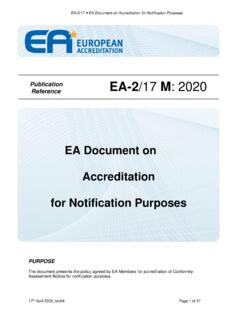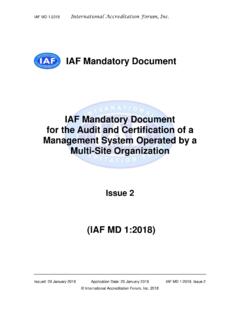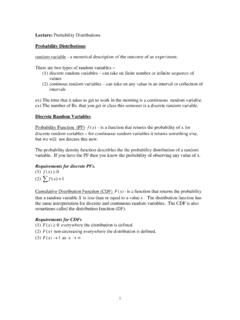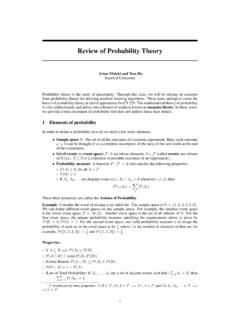Transcription of Reference - European Accreditation
1 EA 4/16 - EA guidelines on the expression of uncertainty in quantitative testing December 2003 rev00 Page 1 of 28 Publication Reference EA guidelines on the expression of uncertainty in quantitative testing PURPOSE The purpose of this document is to harmonise the evaluation of uncertainties associated with measurement and test results within EA. To achieve this, recommendations and advice are given for the evaluation of those uncertainties. EA-4/16 G:2003 EA 4/16 - EA guidelines on the expression of uncertainty in quantitative testing December 2003 rev00 Page 2 of 28 Authorship The EA Expert group on uncertainty of measurement prepared this document on behalf of the EA Laboratory Committee.
2 Official Language The text may be translated into other languages as required. The English language version remains the definitive version. Copyright The copyright of this text is held by EA. The text may not be copied for resale. Further information For further information about this publication, contact your National member of EA. Please check our website for up-to-date information. Category: Application documents and Technical Advisory documents for Conformity Assessment Bodies EA-4/16 is a guidance document Date of endorsement : November 2003 Date of implementation : November 2004 Transitional period : one year EA 4/16 - EA guidelines on the expression of uncertainty in quantitative testing December 2003 rev00 Page 3 of 28 CONTENTS 1 INTRODUCTION 2 SCOPE OF APPLICATION 3 POLICY STATEMENT 4 BRIEF SUMMARY OF THE GUM 5 TUTORIAL ON MEASUREMENT AND QUANTITATIVE TESTING Requirements Specific difficulties of uncertainty evaluation in testing 6 USE OF VALIDATION AND METHOD PERFORMANCE DATA FOR UNCERTAINTY EVALUATION Sources of method performance and validation data Data accumulated during validation and verification of a test method prior to application in the testing environment Interlaboratory study of test methods performance according to ISO 5725 or
3 Equivalent Test or measurement process quality control data Proficiency testing data Significance of uncertainty contributions Use of prior study data 7 REPORTING RESULTS OF A QUANTITATIVE TEST 8 STEPWISE IMPLEMENTATION OF THE UNCERTAINTY CONCEPT 9 ADVANTAGES OF UNCERTAINTY EVALUATION FOR TESTING LABORATORIES 10 REFERENCES 11 BIBLIOGRAPHY 12 APPENDIX EA 4/16 - EA guidelines on the expression of uncertainty in quantitative testing December 2003 rev00 Page 4 of 28 1 INTRODUCTION The Guide to the Expression of Uncertainty in Measurement (GUM) [1] is recognised by EA as the master document on measurement uncertainty. Therefore, consistency with the GUM is generally required for specific guidance or recommendations for the evaluation of measurement uncertainty in any field of application associated with EA activity.
4 In general, the GUM is also applicable in testing, although there are decisive differences between measurement and testing procedures. The very nature of some testing procedures may make it difficult to apply the GUM strictly. Section 6 provides guidance on how to proceed in such cases. Wherever possible accredited testing laboratories are required, when reporting the uncertainties associated with quantitative results, to do so in accordance with the GUM. A basic requirement of the GUM is the use of a model for the evaluation of uncertainty. The model should include all quantities that can contribute significantly to the uncertainty associated with the test result.
5 There are circumstances, however, where the effort required developing a detailed model is unnecessary. In such a case other identified guidance should be adopted, and other methods based, for example on validation and method performance data be used. To ensure that clients benefit fully from laboratories services, accredited testing laboratories have developed appropriate principles for their collaboration with clients. Clients have the right to expect that the test reports are factually correct, useful and comprehensive. Depending on the situation, clients are also interested in quality features, especially the reliability of the results and a quantitative statement on this reliability, uncertainty the level of confidence of a conformity statement about the product that can be inferred from the testing result and the associated expanded uncertainty.
6 Other quality features such as repeatability, intermediate precision reproducibility, trueness, robustness and selectivity are also important for the characterisation of the quality of a test method. This document does not deal with the use of uncertainty in conformity assessment. In general, the quality of a test result does not reflect the best achievable or the smallest uncertainty. Section 2 defines the scope of application of this guide and Section 3 presents a policy statement jointly made by EUROLAB, EURACHEM and EA. Sections 4, 5 and 6 are tutorial. Section 4 provides a brief summary of the GUM.
7 Section 5 summarises the existing requirements according to ISO/IEC 17025 [7] and the strategy for the implementation of uncertainty evaluation. It also addresses some difficulties associated with uncertainty evaluation in testing. Section 6 explains the use of validation and method performance data for evaluating uncertainty in testing. EA requirements on reporting the result of a measurement are given in Section 7. Guidance on a stepwise implementation of uncertainty in testing is provided in Section 8. The benefits of elaborating the uncertainty associated with the values obtained in quantitative testing are indicated in Section 9. EA 4/16 - EA guidelines on the expression of uncertainty in quantitative testing December 2003 rev00 Page 5 of 28 2 SCOPE OF APPLICATION This document is intended to provide guidance for the evaluation1 of uncertainty in quantitative testing.
8 Any test involving the determination of a numerical value of a measurand or a characteristic is called quantitative testing. For the evaluation of uncertainty in calibration, EA 4/02 [11] should be consulted. 3 POLICY STATEMENT Extract from ILAC-G17:2002 Introducing the Concept of Uncertainty of Measurement in Testing in Association with the Application of the Standard ISO/IEC 17025 [15] : 1. The statement of uncertainty of measurement should contain sufficient information for comparative purposes; 2. The GUM and ISO/IEC 17025 form the basic documents but sector specific interpretations may be needed; 3. Only uncertainty of measurement in quantitative testing is considered for the time being.
9 A strategy on handling results from qualitative testing has to be developed by the scientific community; 4. The basic requirement should be either an estimation of the overall uncertainty, or identification of the major components followed by an attempt to estimate their size and the size of the combined uncertainty; 5. The basis for the estimation of uncertainty of measurement is to use existing experimental data should be used (quality control charts, validation, round robin tests, PT, CRM, handbooks etc.); 6. When using a standard test method there are three cases: when using a standardised test method, which contains guidance to the uncertainty evaluation, testing laboratories are not expected to do more than to follow the uncertainty evaluation procedure as given in the standard2; if a standard gives a typical uncertainty of measurement for test results, laboratories are allowed to quote this figure if they can demonstrate full compliance with the test method; if a standard implicitly includes the uncertainty of measurement in the test results there is no further action necessary2.
10 Testing laboratories should not be expected to do more than take notice of, and apply the uncertainty-related information given in the standard, quote the applicable figure, or perform the applicable procedure for uncertainty estimation. Standards specifying test methods should be reviewed concerning estimation and statement of uncertainty of test results, and revised accordingly by the standards organisation. 7. The required depth of the uncertainty estimations may be different in different technical fields. Factors to be taken into account include: common sense; influence of the uncertainty of measurement on the result (appropriateness of the determination); appropriateness; classification of the degree of rigour in the determination of uncertainty of measurement.






